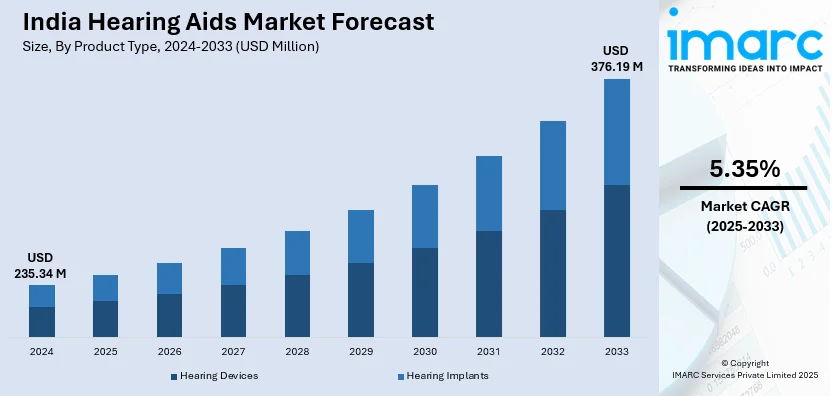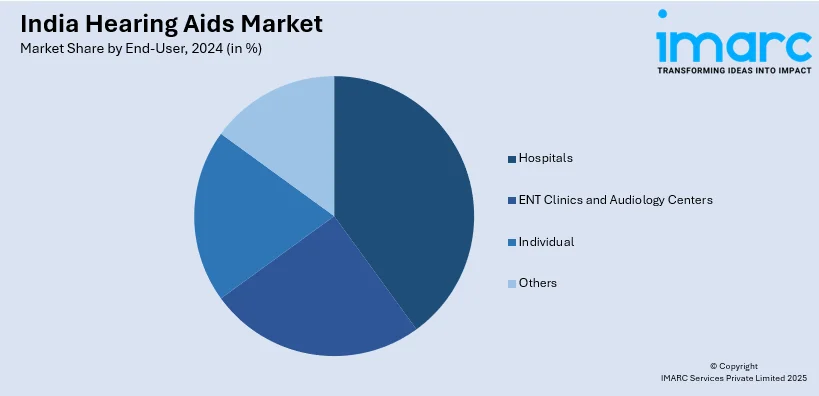
India Hearing Aids Market Size, Share, Trends and Forecast by Product Type, Hearing Loss, Patient Type, Technology Type, End-User, and Region, 2025-2033
India Hearing Aids Market Overview:
The India hearing aids market size reached USD 235.34 Million in 2024. Looking forward, IMARC Group expects the market to reach USD 376.19 Million by 2033, exhibiting a growth rate (CAGR) of 5.35% during 2025-2033. The growing elderly population and rising awareness among masses along with improved diagnosis rates are driving the India hearing aids market share. Moreover, technological advancements enhance user experience, while government initiatives provide financial support, making hearing aids more accessible in India.
|
Report Attribute
|
Key Statistics
|
|---|---|
|
Base Year
|
2024
|
|
Forecast Years
|
2025-2033
|
|
Historical Years
|
2019-2024
|
| Market Size in 2024 | USD 235.34 Million |
| Market Forecast in 2033 | USD 376.19 Million |
| Market Growth Rate 2025-2033 | 5.35% |
India Hearing Aids Market Trends:
Increasing Awareness and Diagnosis Rates
Increasing awareness and diagnosis rates are significantly strengthening the India hearing aids market growth. Awareness campaigns are educating people about hearing loss and the benefits of using hearing aids. The WHO estimates that around 63 million people in India experience Significant Auditory Impairment, with an estimated prevalence of 6.3% in the country's population. Early diagnosis helps individuals seek timely treatment, improving their quality of life and communication abilities. Schools, workplaces, and healthcare institutions are actively promoting hearing health and regular hearing check-ups. Medical professionals are emphasizing the importance of hearing assessments, encouraging more people to get tested. Government programs and NGOs are spreading awareness about hearing impairment through workshops and community initiatives. Media platforms are playing a crucial role in informing the public about hearing loss solutions. Rural healthcare centers are improving diagnostic facilities, making hearing loss detection easier and more accessible. Parents are becoming more aware of congenital hearing loss, leading to early intervention for children. Corporate health programs are including hearing tests, ensuring employees address auditory issues at an early stage. Rising internet penetration is enabling people to research hearing loss symptoms and available treatment options, further driving the demand for hearing aids.

To get more information on this market, Request Sample
Rising Geriatric Population
Aging naturally leads to hearing impairment, influencing the India hearing aids market outlook. With life expectancy improving, a larger elderly population requires advanced hearing assistance devices. As per UNFPA, India's elderly population is growing at a decadal rate of 41% and is projected to exceed 20% of the total population by 2050. Age-related hearing loss, known as presbycusis, is becoming more prevalent among senior citizens. Many elderly individuals experience difficulties in communication, impacting their quality of life and social interactions. Hearing aids help them regain auditory functions, improving their independence and overall well-being. Increased awareness about age-related hearing issues is encouraging senior citizens to seek medical interventions. Families and caregivers are also supporting elderly individuals in adopting hearing aids for better communication. The availability of technologically advanced hearing aids is making them more appealing to the aging population. Features like noise reduction, Bluetooth connectivity, and rechargeable batteries enhance the user experience for elderly users. Government initiatives and healthcare programs are also providing financial assistance to senior citizens. Increased healthcare access is allowing early diagnosis and treatment of age-related hearing loss. The UNFPA's 2023 India Ageing Report projects that by 2046, India's elderly population will likely exceed the number of children aged 0 to 15 years, highlighting the increasing demand for hearing aid solutions to support age-related auditory challenges. Audiology clinics and ENT specialists are expanding their services for catering to elderly patients’ needs.
India Hearing Aids Market Segmentation:
IMARC Group provides an analysis of the key trends in each segment of the market, along with forecasts at the regional level for 2025-2033. Our report has categorized the market based on product type, hearing loss, patient type, technology type, and end-user.
Product Type Insights:
- Hearing Devices
- Behind-the-Ear (BTE)
- Receiver-in-the Ear (RITE)
- In-the-Ear (ITE)
- Canal Hearing Aids (CHA)
- Others
- Hearing Implants
- Cochlear Implants
- BAHA Implants
The report has provided a detailed breakup and analysis of the market based on the product type. This includes hearing devices (behind-the-ear (BTE), receiver-in-the ear (RITE), in-the-ear (ITE), canal hearing aids (CHA), and others) and hearing implants (cochlear implants and BAHA implants).
Hearing Loss Insights:
- Sensorineural Hearing Loss
- Conductive Hearing Loss
A detailed breakup and analysis of the market based on the hearing loss have also been provided in the report. This includes sensorineural hearing loss, and conductive hearing loss.
Patient Type Insights:
- Adults
- Pediatrics
The report has provided a detailed breakup and analysis of the market based on the patient type. This includes adults and pediatrics.
Technology Type Insights:
- Analog
- Digital
A detailed breakup and analysis of the market based on the technology have also been provided in the report. This includes analog and digital.
End-User Insights:

- Hospitals
- ENT Clinics and Audiology Centers
- Individual
- Others
The report has provided a detailed breakup and analysis of the market based on the end-user. This includes hospitals, ENT clinics and audiology centers, individual, and others.
Regional Insights:
- North India
- South India
- East India
- West India
The report has also provided a comprehensive analysis of all the major regional markets, which include North India, South India, East India, and West India.
Competitive Landscape:
The market research report has also provided a comprehensive analysis of the competitive landscape. Competitive analysis such as market structure, key player positioning, top winning strategies, competitive dashboard, and company evaluation quadrant has been covered in the report. Also, detailed profiles of all major companies have been provided.
India Hearing Aids Market News:
- In February 2025, Starkey, a leading global hearing technology company, introduced its Genesis AI hearing aids in India to support the needs of around 63 million people experiencing significant auditory impairment.
- In January 2025, Hearzap, backed by 360 One, introduced Zenaud, India's first rechargeable In-the-Canal (ITC) hearing aid, developed by GN Hearing. Priced from ₹16,499, Zenaud aims to expand access to advanced hearing technology across 11 states, benefiting nearly 697.56 million people.
India Hearing Aids Market Report Coverage:
| Report Features | Details |
|---|---|
| Base Year of the Analysis | 2024 |
| Historical Period | 2019-2024 |
| Forecast Period | 2025-2033 |
| Units | Million USD |
| Scope of the Report |
Exploration of Historical Trends and Market Outlook, Industry Catalysts and Challenges, Segment-Wise Historical and Future Market Assessment:
|
| Product Types Covered |
|
| Hearing Losses Covered | Sensorineural Hearing Loss, Conductive Hearing Loss |
| Patient Types Covered | Adults, Pediatrics |
| Technology Types Covered | Analog, Digital |
| End-Users Covered | Hospitals, ENT Clinics and Audiology Centres, Individual, Others |
| Regions Covered | North India, South India, East India, West India |
| Customization Scope | 10% Free Customization |
| Post-Sale Analyst Support | 10-12 Weeks |
| Delivery Format | PDF and Excel through Email (We can also provide the editable version of the report in PPT/Word format on special request) |
Key Benefits for Stakeholders:
- IMARC’s industry report offers a comprehensive quantitative analysis of various market segments, historical and current market trends, market forecasts, and dynamics of the India hearing aids market from 2019-2033.
- The research report provides the latest information on the market drivers, challenges, and opportunities in the India hearing aids market.
- Porter's five forces analysis assist stakeholders in assessing the impact of new entrants, competitive rivalry, supplier power, buyer power, and the threat of substitution. It helps stakeholders to analyze the level of competition within the India hearing aids industry and its attractiveness.
- Competitive landscape allows stakeholders to understand their competitive environment and provides an insight into the current positions of key players in the market.
Key Questions Answered in This Report
The hearing aids market in India was valued at USD 235.34 Million in 2024.
The India hearing aids market is projected to exhibit a CAGR of 5.35% during 2025-2033, reaching a value of USD 376.19 Million by 2033.
A growing elderly population, better awareness, expanding private healthcare, government initiatives for disability support, and technological upgrades are pushing India’s hearing aids market. Urbanization, rising income, and more audiologists in tier 2 and 3 cities are making diagnosis and adoption easier. Demand for discreet, smart devices fuels growth too.
Need more help?
- Speak to our experienced analysts for insights on the current market scenarios.
- Include additional segments and countries to customize the report as per your requirement.
- Gain an unparalleled competitive advantage in your domain by understanding how to utilize the report and positively impacting your operations and revenue.
- For further assistance, please connect with our analysts.
 Request Customization
Request Customization
 Speak to an Analyst
Speak to an Analyst
 Request Brochure
Request Brochure
 Inquire Before Buying
Inquire Before Buying




.webp)




.webp)












